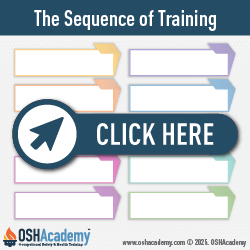Go!
The Sequence of Training
You've completed preparing for the training session, greeted students as they arrived, and now it's time to start training, so what's next? Let's first look at the general sequence of activities in most training activities.
The training presentation generally follows the sequence below.
- Start the training session: OK, now you've completed the prep work, greeted the students as they arrived, and it's time to begin the actual training. Most sessions follow a set sequence that helps participants stay engaged and remember what they've learned. Each step builds on the last to create a smooth and effective learning experience.
- Thank them for attending: Begin with a warm welcome and a quick thank-you. Saying something like, "Thanks for being here today—we appreciate your commitment to safety," sets a respectful and positive tone from the start.
- Conduct introductions: Introduce yourself, and if appropriate, ask students to introduce themselves. Go over the basics of the training location. Point out restrooms, exits, and break areas. Share emergency procedures, such as, "In case of a fire, exit through the doors behind you and meet in the parking lot near the main gate."
- Preview the training: Give a quick preview of the training content. For example, "Today we'll cover fall protection, including harness inspection, fitting, and choosing proper anchor points."
- Present the training: Present the the main ideas and concepts using a mix of methods such as slides, demonstrations, and videos. For instance, for fall protection training, explain how to inspect and wear a harness and what to check before working at height. Use real equipment when possible to make it more relatable.
- Discuss the benefits of the training: Tell them why the training is important. Explain the value of the training. Say something like, "Learning this could be the difference between going home safely or getting seriously hurt. We want everyone to be confident and prepared."
- Conduct activities: Have them to do Something. Let students apply what they've learned. Set up stations for harness inspections or have them work in small groups to identify hazards. Hands-on practice helps reinforce the lesson. After the activity, connect it back to real-world safety. For example, "Practicing now helps build confidence so you won't hesitate when it really matters on the job."
- Review the training: Tell them what you told them. Repeat the key points of the session. You might say, "We talked about harness inspection, correct fitting, and how to choose safe anchor points. These steps can save your life on site."
- Test student knowledge: Have students take a written test or demonstrate skills: Assess what students learned with a quiz or practical test. For example, when conducting fall protection training, you might ask them to demonstrate how to inspect and wear a harness properly, or answer scenario-based questions.
- Evaluate the training: Distribute student evaluation forms to get feedback on the training. Collect all required paperwork like attendance sheets, test results, and certificates for compliance.
- Thank them again for coming: End on a positive note. Say, "Thank you again for your time and focus today. Your safety is important, and we're glad you were here to take part in this session."
- Conduct post-training evaluation and documentation: After the training is finished, don't just wrap things up and move on. You'll want to evaluate how well the session went. Pass out feedback forms to hear their thoughts on what worked and what could be better next time.
Be sure to collect and save all the important paperwork—like sign-in sheets, test results, and certificates. Keeping good records helps you prove compliance and makes future planning easier. And don't forget about follow-up. Schedule refresher courses when needed and check in to see how well employees are using their new skills on the job. That's how you build a lasting safety culture.
If you get that sequence down and follow it regularly, you are much more likely to be successful every time you train.
Knowledge Check Choose the best answer for the question.
3-1. What should you do before presenting the main ideas in your training session?
You forgot to answer the question!

